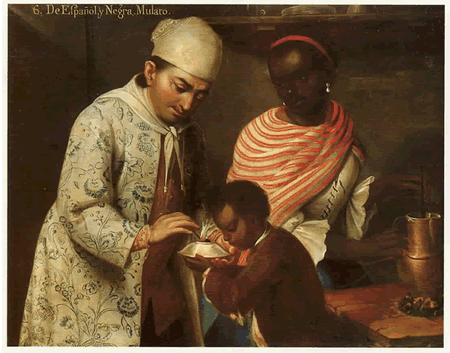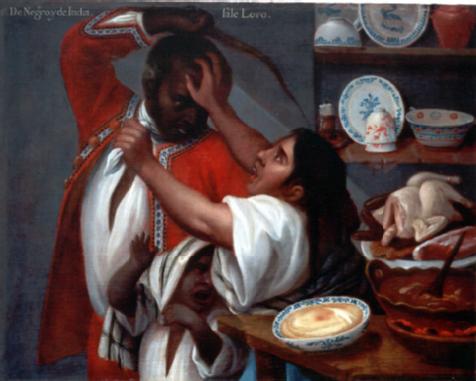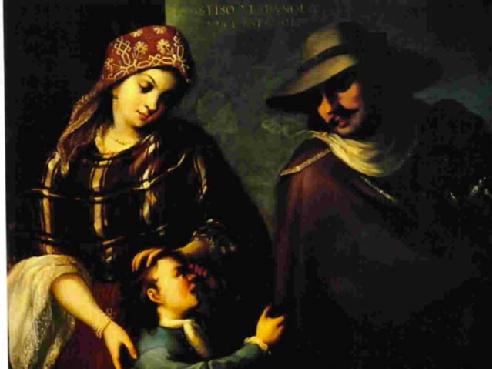Withdrawn Module: Casta Painting: Art, Race and Identity in Colonial Mexico (HI972)
Please note that this module was available
until 2013, but has since been
withdrawn and is no longer available.
Module Leader: Professor Rebecca Earle
Module Handbook

Miguel de Cabrera, De Español y Negra, Mulato
Context
This module, taught in the Spring term, may be taken by students on the MA in History, the MA in Modern History, the MA in Comparative American Studies, the MA in Global History, the MA in Eighteenth-Century Studies, the MA in Religious, Social and Cultural History, or any taught Master's student outside the History Department.
Module Aims
This module explores the distinctive vision of colonial Mexico purveyed via the artistic genre known as the casta painting. Casta paintings depict the outcomes of different types of inter-ethnic mixing, and often come in series of 16, showing many different family groups. They are quite remarkable. Consider, for example, José de Alcíbar's painting showing a family group consisting, we are told in the helpful label, of a Black father, and Indian mother and their 'Wolf' son:

José de Alcíbar, De Negro y De India Sale Lovo
Casta paintings can be seen as attempts at cataloguing the varied inhabitants of Spain’s colonial universe. They thus offer a visual taxonomy of colonial space. At the same time, they have been read as statements of local pride, and usually include a wealth of details about local customs and habits. In addition, they are rich and complex documents relating to the material culture of colonial Spanish America. In Alcíbar's painting reproduced above we notice not only the domestic strife but also the beautiful china (which is endangered by the parental row) and food items such as the headless chicken. How are we to interpret and understand such images?
The module will introduce students to this artistic genre, and will explore different ways of interpreting these multi-valent images. Its educational aims, therefore, are to help students consider how to read artistic works produced in a colonial setting, how to use casta paintings as a body of source material, and how to explore the relationship between visual and textual depictions of colonial space.
Learning Outcomes: By the end of this module you will be able to:
-
Assess the historiographic treatment of race in colonial Mexico.
-
Understand and evaluate the scholarly literature on the emergence of creole patriotism in eighteenth-century Mexico
- Show that you have improved your research and presentation skills
-
Recognise and evaluate the different ways in which scholars in different disciplines have interpreted casta paintings
-
Discuss the challenges posed by the use of casta paintings as a historical source.
-
Apply your scholarly and theoretical knowledge to the analysis of a specific casta painting
Outline Syllabus
Week 1: Introduction
Week 2: Race and Caste in 18th-century Mexico
Week 3: Racial Taxonomies
Week 4: Creole Patriotisms
Week 5: Caste, Class and Occupation
Week 6: Reading Week
Week 7: Trip to Breamore House (Hampshire) to view collection of casta paintings
Week 8: Student presentations. Each student will present an analysis of a specific casta painting, ideally one from the Breamore House collection.
Week 9: Student presentations, con’t.
Week 10: Conclusions: Race, Class and the Colonial Imagination

Juan Rodríguez Juárez, De Castiso y Española Produce Español (Breamore House)
Illustrative Bibliography
Artes de México: La pintura de castas, no. 8 (1990).
Carrera, Magali, Imagining Identity in New Spain: Race, Lineage, and the Colonial Body in Portraiture and Casta Paintings, University of Texas Press (Austin, 2003).
Cope, R. Douglas, The Limits of Racial Domination: Plebeian Society in Colonial Mexico City, 1660-1720, University of Wisconsin Press (Madison, 1994).
Deans-Smith, Susan, ‘Creating the Colonial Subject: Casta Paintings, Collectors, and Critics in Eighteenth-Century Mexico and Spain’, Colonial Latin American Review 14:2 (2005).
Earle, Rebecca, ‘‘Two Pairs of Pink Satin Shoes!!’: Clothing, Race and Identity in the Americas, 17th-19th Centuries’, History Workshop Journal, issue 52 (2001).
Earle, Rebecca, ‘Consumption and Excess in Colonial and Early Independent Spanish America’, Imported Modernity in Post-Colonial State-Formation: The Appropriation of Political, Educational and Cultural Models in Nineteenth-Century Latin America, eds. Marcelo Caruso and Eugenia Roldán Vera, Peter Lang (Frankfurt am Main, 2007).
Katzew, Ilona, ed., New World Orders. Casta Painting and Colonial Latin America, Americas Society (New York, 1996).
Katzew, Ilona, Casta Painting: Images of Race in Eighteenth-century Mexico, Yale University Press (New Haven, 2004).
Loren, Diana DiPaulo, ‘Corporeal Concerns: Eighteenth-Century Casta Paintings and Colonial Bodies in Spanish
Viqueira Albán, Juan Pedro, Propriety and Permissiveness in Bourbon Mexico, trans. Sonya Lipsett-Rivera and Sergio Rivera Ayala, SR Books (Wilmington, 1999).
Assessment
1 assessed essay of 5,000 words and one optional unassessed essay of 2,500 words.
